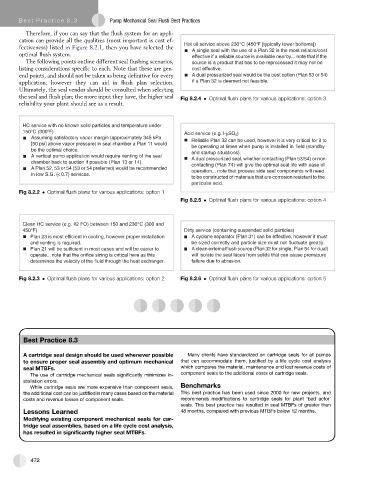Page 501 - Subyek Teknik Mesin - Forsthoffers Best Practice Handbook for Rotating Machinery by William E Forsthoffer
P. 501
Be st Practice 8 .3 Pump Mechanical Seal Flush Best Practices
Therefore, if you can say that the flush system for an appli-
Therefore, if you can say that the flush system for an appli-
cation can provide all the qualities (most important is cost ef-
cation can provide all the qualities (most important is cost ef-
fectiveness) listed in Figure 8.2.1, then you have selected the Hot oil service above 230°C (450°F [typically tower bottoms])
fectiveness) listed in Figure 8.2.1, then you have selected the
A single seal with the use of a Plan 32 is the most reliable/cost
optimal flush system.
optimal flush system. effective if a reliable source is available nearby... note that if the
The following points outline different seal flushing scenarios, source is a product that has to be reprocessed it may not be
The following points outline different seal flushing scenarios,
listing considerations specific to each. Note that these are gen-
listing considerations specific to each. Note that these are gen- cost effective.
eral points, and should not be taken as being definitive for every A dual pressurized seal would be the best option (Plan 53 or 54)
eral points, and should not be taken as being definitive for every
application; however they can aid in flush plan selection.
application; however they can aid in flush plan selection. if a Plan 32 is deemed not feasible.
Ultimately, the seal vendor should be consulted when selecting
Ultimately, the seal vendor should be consulted when selecting
the seal and flush plan; the more input they have, the higher seal Fig 8.2.4 Optimal flush plans for various applications: option 3
the seal and flush plan; the more input they have, the higher seal
reliability your plant should see as a result.
reliability your plant should see as a result.
HC service with no known solid particles and temperature under
150°C (300°F) Acid service (e.g. H 2 SO 4 )
Assuming satisfactory vapor margin (approximately 345 kPa
Reliable Plan 32 can be used, however it is very critical for it to
[50 psi] above vapor pressure) in seal chamber a Plan 11 would
be operating at times when pump is installed in field (standby
be the optimal choice.
and startup situations).
A vertical pump application would require venting of the seal
A dual pressurized seal, whether contacting (Plan 53/54) or non-
chamber back to suction if possible (Plan 13 or 14). contacting (Plan 74) will give the optimal seal life with ease of
A Plan 52, 53 or 54 (53 or 54 preferred) would be recommended operation... note that process side seal components will need
in low S.G. (< 0.7) services.
to be constructed of materials that are corrosion resistant to the
particular acid.
Fig 8.2.2 Optimal flush plans for various applications: option 1
Fig 8.2.5 Optimal flush plans for various applications: option 4
Clean HC service (e.g. #2 FO) between 150 and 230°C (300 and
450°F) Dirty service (containing suspended solid particles)
Plan 23 is most efficient in cooling, however proper installation A cyclone separator (Plan 31) can be effective, however it must
and venting is required. be sized correctly and particle size must not fluctuate greatly.
Plan 21 will be sufficient in most cases and will be easier to A clean externalflush source (Plan 32 for single, Plan 54 for dual)
operate... note that the orifice sizing is critical here as this will isolate the seal faces from solids that can cause premature
determines the velocity of the fluid through the heat exchanger. failure due to abrasion.
Fig 8.2.3 Optimal flush plans for various applications: option 2 Fig 8.2.6 Optimal flush plans for various applications: option 5
Best
Best Practice 8.3Practice 8.3
A cartridge seal design should be used whenever possible Many clients have standardized on cartridge seals for all pumps
to ensure proper seal assembly and optimum mechanical that can accommodate them, justified by a life cycle cost analysis
seal MTBFs. which compares the material, maintenance and lost revenue costs of
The use of cartridge mechanical seals significantly minimizes in- component seals to the additional costs of cartridge seals.
stallation errors.
While cartridge seals are more expensive than component seals, Benchmarks
the additional cost can be justified in many cases based on the material This best practice has been used since 2000 for new projects, and
costs and revenue losses of component seals. recommends modifications to cartridge seals for plant ‘bad actor’
seals. This best practice has resulted in seal MTBFs of greater than
Lessons Learned 48 months, compared with previous MTBFs below 12 months.
Modifying existing component mechanical seals for car-
tridge seal assemblies, based on a life cycle cost analysis,
has resulted in significantly higher seal MTBFs.
472

